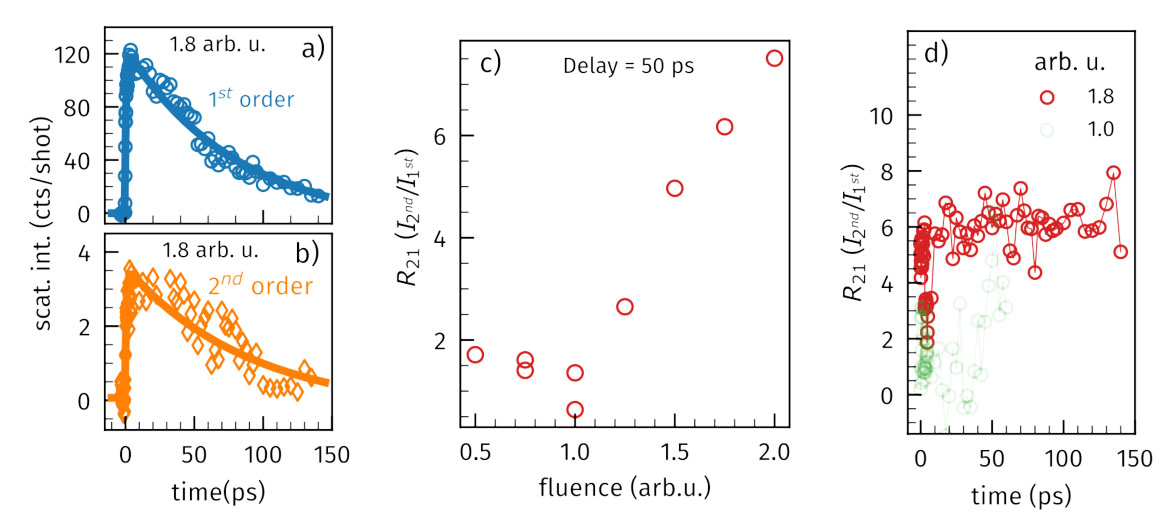| Jun 15, 2022 |
All-optical switching on the nanometer scale
(Nanowerk News) Ultrafast light-driven control of magnetization on the nanometer length scale is key to achieve competitive bit sizes in next generation data storage technology. Researchers at Max Born Institute in Berlin and of the large scale facility Elettra in Trieste, Italy, have successfully demonstrated the ultrafast emergence of all-optical switching by generating a nanometer scale grating by interference of two pulses in the extreme ultraviolet spectral range ("All-Optical Switching on the Nanometer Scale Excited and Probed with Femtosecond Extreme Ultraviolet Pulses").
|
|
The physics of optically driven magnetization dynamics on the femtosecond time scale has become of great interest for two main reasons: first, understanding the fundamental mechanisms of nonequilibrium, ultrafast spin dynamics and, second, the potential application in the next generation of information technology with a vision to satisfy the need for both faster and more energy efficient data storage devices.
|
|
All-optical switching (AOS) is one of the most interesting and promising mechanisms for this endeavor, where the magnetization state can be reversed between two directions with a single femtosecond laser pulse, serving as “0s” and “1s”. While the understanding of the temporal control of AOS has progressed rapidly, knowledge on ultrafast transport phenomena on the nanoscale, important for the realization of all-optical magnetic reversal in technological applications, has remained limited due to the wavelength limitations of optical radiation.
|
|
An elegant way to of overcoming these restrictions is to reduce the wavelengths to the extreme ultraviolet (XUV) spectral range in transient grating experiments. This technique is based on the interference of two XUV beams leading to a nanoscale excitation pattern and has been pioneered at the EIS-Timer beamline of the free-electron laser (FEL) FERMI in Trieste, Italy.
|
|
In this work, researchers from the Max-Born-Institute, Berlin and the FEL facility FERMI excited a transient magnetic grating (TMG) with a periodicity of ΛTMG = 87 nm in a ferrimagnetic GdFe alloy sample. The spatial evolution of the magnetization grating was probed by diffracting a time-delayed, third XUV pulse tuned to the Gd N-edge at a wavelength of 8.3 nm (150 eV).
|
|
As AOS exhibits a strongly non-linear response to the excitation, one expects characteristic symmetry changes of the evolving magnetic grating distinct from the initial sinusoidal excitation pattern. This information is directly encoded in the diffraction pattern: in case of a linear magnetization response to the excitation and no AOS, a sinusoidal TMG is induced and the second diffraction order is suppressed. However, if AOS occurs, the grating shape changes, now allowing for a pronounced second order diffraction intensity.
|
|
In other words, the researchers identified the intensity ratio between the second and first order (R21) as a fingerprint observable for AOS in diffraction experiments.
|
 |
| Figure 1 a) First and b) second order diffraction intensity as a function of the time delay between the pump and probe beams. c) Intensity ratio between the second and first diffraction order (R21) as a function of excitation fluence at a delay of 50 ps. At a fluence of 1.3 arb.u., the transient magnetization grating starts to change its shape leading to the emergence of the second diffraction order, a fingerprint for AOS. d) The ratio R21 for a high excitation fluence (red circles) exhibits a large and constant ratio, which we identify as the emergence of a stable magnetic structures and therefore as additional evidence for AOS on the nanometer spatial scale. (Image: Max Born Institute)
|
|
Figure 1 a) and b) show the temporal evolution of the diffracted first and second order intensities, respectively. The researchers find comparable decay times of τRE,first = (81 ± 7) ps and τRE,second = (90 ± 24) ps, consistent with lateral heat diffusion rates of the nanoscale gratings. Figure 1 c), shows the ratio R21 as a function of the excitation fluence at a constant pump-probe delay of 50 ps.
|
|
For low fluence below the threshold of AOS, the research team observed a constant and small value of R21 of around 1%. Increasing the excitation, however, R21 shows a steady rise to ~8%, providing first evidence for AOS on the nanometer length scale.
|
|
The ratio R21 as a function of time is shown in Figure 1 d) for two selected excitation fluences. For the larger fluence (red circles) R21 exhibits an elevated and constant ratio of about 6% over the measured time interval of 150 ps, indicative of a stable magnetic structure, which is interpreted as optically reversed domains, i.e. AOS.
|
|
Finally, the researchers were able to confirm their observations by complementary all-optical measurements in real space using time-resolved Faraday microscopy.
|
|
In future transient grating experiments with significantly smaller periodicities down to <20 nm, ultrafast lateral transport processes are expected to equilibrate the excitation gradients within a few picoseconds and will therefore define the fundamental spatial limits of AOS.
|

